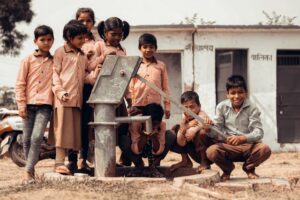Physical Address
23,24,25 & 26, 2nd Floor, Software Technology Park India, Opp: Garware Stadium,MIDC, Chikalthana, Aurangabad, Maharashtra – 431001 India
Physical Address
23,24,25 & 26, 2nd Floor, Software Technology Park India, Opp: Garware Stadium,MIDC, Chikalthana, Aurangabad, Maharashtra – 431001 India

Climate change is no longer a distant worry—it is a growing crisis reshaping the future of millions of children across India. From devastating floods that wash away schools to extreme heatwaves that make learning unbearable, climate-related disruptions are forcing students out of classrooms and widening the education gap. With India ranking 26th on UNICEF’s Children’s Climate Risk Index, the urgency to protect children’s education from the worsening effects of climate change has never been greater. Without immediate action, the nation’s youngest generation risks losing access to learning and the opportunity for a secure and prosperous future.
Extreme Weather and Its Impact on Education
Climate change is not a distant threat—it is a daily reality for millions of Indian children. Floodwaters submerge villages, heatwaves make outdoor learning impossible, and cyclones damage schools in coastal and inland areas alike. These disasters not only destroy infrastructure but also create long-term barriers to learning and development.
Innovative Solutions for Continued Learning
The COVID-19 pandemic demonstrated the effectiveness of low-tech, no-tech, and high-tech learning solutions. By leveraging radio, television, community learning hubs, online platforms, educational videos, and interactive apps, education can continue despite school closures. These solutions are critical in ensuring that climate disruptions do not permanently affect children’s learning progress.
In Bihar, digital tools are used in the ‘Safe Saturday’ program, which teaches disaster preparedness while keeping students academically engaged. Kerala has integrated climate change and disaster management into its curriculum, using digital content to reach remote areas. Gujarat’s self-paced school safety course has been implemented in tens of thousands of schools, equipping students with crucial survival skills.
Empowering Students Through Climate Action
Children and adolescents worldwide are leading calls for climate action. While formal education plays a vital role, co-curricular and extracurricular activities are equally important in preparing students to navigate real-world challenges and contribute to their communities.
School eco-clubs engage students in activities like tree planting, waste management, and energy conservation, often influencing family and community behavior. In Bihar, UNICEF’s partnership with the Bihar Education Project Council has led to the establishment of eco-clubs in over 75,000 schools. Uttar Pradesh recently hosted a children’s convention on climate change, inspiring state-wide environmental campaigns. Maharashtra’s ‘Youth for Climate Actions’ program has mobilized thousands of young advocates, integrating climate education into school programs. Assam introduced the Chief Minister’s Climate Resilient Village Fellowship Programme. It aims to increase climate change resilience awareness and empower younger generations to become climate-smart leaders.
The Need for Climate-Resilient Learning Spaces
With climate change increasing the frequency and severity of natural disasters, there is an urgent need to develop resilient and adaptable learning infrastructure. Traditional responses, such as deploying tents and temporary learning spaces, have proven inadequate. These short-term solutions often compromise safety, drive up reconstruction costs, and contribute to carbon emissions, further worsening environmental challenges. Instead, long-term, sustainable strategies are needed to ensure that education continues uninterrupted, even in the face of climate crises.
Building a Climate-Resilient Future
As climate events grow more frequent and severe, stronger measures are needed to safeguard education. Developing early warning systems, constructing climate-resilient school buildings, and equipping children with skills to adapt and thrive in a changing world are crucial steps. Strengthening the resilience of schools and communities will not only protect children’s education but also contribute to a greener, more sustainable future.
The story of millions of children underscores the urgency of this mission. Children are not just statistics; they are symbols of strength and resilience. With the right support, they can overcome the challenges posed by climate change and shape a better tomorrow.
References:
https://www.unicef.org/india/what-we-do/climate-change
https://wri-india.org/blog/climate-proofing-assam-data-driven-approach
https://www.unicef.org/supply/building-climate-and-disaster-resilient-schools
Photo by Akela Photography https://www.pexels.com/photo/shallow-focus-photography-of-girl-448877/
Banner Image: Photo by Ritesh Arya https://www.pexels.com/photo/children-standing-next-to-manual-water-pump-3079978/